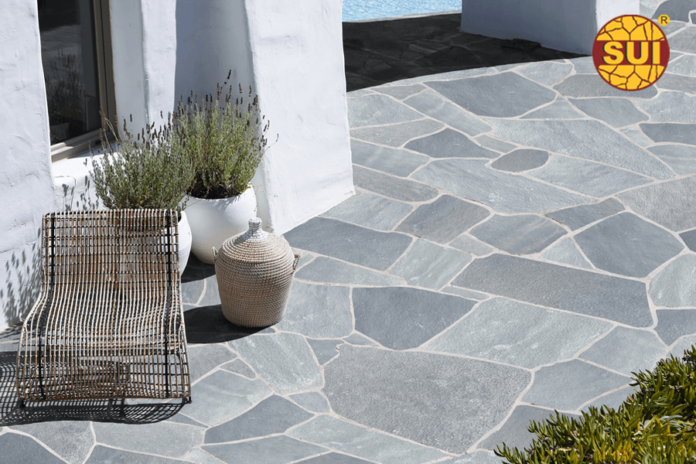A flagstone patio brings timeless beauty and natural texture to any outdoor space, but achieving a polished, long-lasting finish requires thoughtful planning and smart installation techniques. Home landscaping studies show that patios built with the right foundation, proper layout, and quality craftsmanship maintain their strength and appearance far longer. Instead of worrying about common issues, the key is to focus on proven methods that elevate both durability and design.
From selecting the right stones to preparing the base and placing each piece with intention, these smart steps can help you create a patio that feels cohesive, stable, and inviting. With the right approach, your flagstone patio can truly become the highlight of your outdoor living area.
1. Proper Patio Grading
One of the biggest mistakes people make is ignoring proper grading. Flagstone patios must be slightly elevated and gently sloped to prevent water accumulation. When the surface holds water, the moisture settles under the stones, which leads to shifting, cracking, and long-term structural issues.
A correct grade ensures the following:
- Smooth water flow away from the patio
- Prevention of puddles
- Reduced risk of freeze-thaw damage
Even a small grading error can cause big issues later. Before laying your flagstone, take time to choose the right spot, understand the slope of the surrounding land, and prepare proper drainage channels. Whether you’re doing it yourself or hiring help, ask your contractor about the slope, drainage, and ideal placement of the area.
2. Choosing the Right Patio Size
Another common mistake is misjudging patio size. Homeowners often choose a size that does not meet real-life needs. Before laying your flagstone, think about how you will use the space:
- Is it for quiet evenings?
- Hosting guests?
- Adding outdoor furniture?
- Creating a walkway extension?
A flagstone supplier may offer stones in various colors and stone types, so understanding your space needs will help you make an informed choice. Measure your space carefully, visualize your seating arrangement, and plan for comfortable walking areas.
Proper Base Installation
A strong patio begins with a strong base. One of the worst mistakes is placing flagstone directly on soft or uneven ground. When the earth beneath is not compacted properly, the stones may sink, shift, or create uneven walking surfaces.
To avoid this, you must install a well-prepared base. Depending on the stone thickness chosen from your flagstone supplier, you may need a sand-gravel foundation (flexible base) or a concrete foundation (fixed base).
For example, 1” thick flagstone requires a concrete base, while 1.5” and 2” sandbase flagstone can be set on compacted sand or gravel.
4. Using the Right Stone Thickness
Many homeowners are unaware that flagstone comes in different thicknesses, and each type is meant for a specific installation method. Using the wrong thickness often leads to premature damage.
Here’s a simple guide:
- 1” Concrete Base:
Must be installed on a concrete foundation. - 5” or 2” Sandbase:
Suitable for sand/gravel foundations.
When selecting a flagstone, always match the stone thickness with the foundation method. Using a thin stone on sand or a thick stone on concrete creates an imbalance and reduces durability.
5. Correct Stone Placement and Spacing
Flagstone comes in irregular shapes, which makes placement both creative and challenging. Many DIY installers place stones too close, too far apart, or without proper leveling. This leads to:
- Uneven surfaces
- Trip hazards
- Weak joints
- Poor visual appeal
The right approach is to lay your flagstone pieces like puzzle sections, ensuring stability, natural gaps, and easy movement around the patio. Joint spacing should be consistent enough to maintain the patio’s integrity without looking forced or artificial.
6. Choose/Opt for Professional Installation When Needed
DIY can be tempting, especially with so many online tutorials available, but flagstone installation requires skill, experience, and understanding of foundations, slopes, and stone behavior. Many homeowners attempt DIY installations and end up facing:
- Stone shifting
- Drainage issues
- Uneven surfaces
- Increased repair costs later
Hiring a professional often results in fewer long-term expenses and more durable, attractive results. If you’re investing in quality materials from a flagstone supplier, it makes sense to also invest in proper installation.
7. Choosing High-Quality Flagstone
Not all flagstones are the same. Color consistency, thickness accuracy, surface strength, and natural texture quality all vary between suppliers. Choosing low-quality stone may initially seem like a budget-friendly option, but poor-grade materials can:
- Crack easily
- Erode faster
- Fade under sunlight
- Create uneven surfaces
A reliable flagstone supplier will offer consistent, durable, and naturally beautiful stone options. Quality stone not only lasts longer but also improves the appearance and functionality of your patio.
Conclusion
By following these seven smart ways, you can build a flagstone patio that lasts for years, stays structurally strong, and maintains its natural beauty. From proper grading to choosing the right stone thickness and base, every step plays an important role in the final outcome.
However, while the installation method matters, selecting high-quality material from a dependable flagstone supplier is just as essential. If you’re looking for reliable, durable, and premium-grade flagstone in multiple thickness options, Stone Universe Inc. is a trusted choice across the industry. They offer flagstone in 1” concrete-base, 1.5”, and 2” sand-base options, making it easy to choose what fits your project best.
Upgrade your outdoor space with long-lasting materials, explore the wide collection at Stone Universe Inc., and get started on your dream patio today.

